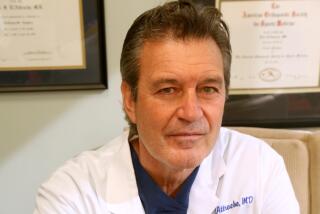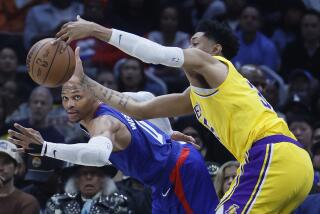Exclusive: Doctor who performed Kobe Bryant’s surgery is optimistic
- Share via
The doctor who performed surgery on Kobe Bryant’s ruptured Achilles’ tendon said he expects the Lakers star to be back playing at some point next season.
Speaking exclusively to The Times, Dr. Neal ElAttrache said Sunday that Bryant’s competitive drive and mental toughness will give him an edge in recovering from an injury that figures to sideline him at least six to nine months.
“I can point to all of the scientific aspects of the repair, but just as important if not more important is, who is that Achilles attached to?” said ElAttrache, who performed the hour-long surgery Saturday. “In this situation, it’s attached to Kobe Bryant, who has figured out a way to get through some injuries that would ordinarily be career-threatening. Some of the things he’s had go on with him have ended guys’ careers in the NBA.
PHOTOS: Kobe Bryant through the years
“He’s figured out a way to get through it and be one of the best players in the NBA.”
ElAttrache, director of the Sports Medicine Fellowship program at Kerlan-Jobe Orthopaedic Clinic in Los Angeles, said Bryant’s Grade 3 rupture was typical of hundreds he has repaired over the last 23 years.
“When they tear, they usually tear in a little bit of a shredded fashion, like two ends of a mop,” said ElAttrache, who declined to detail Bryant’s surgery specifically. “Some of the stitching has to be a little meticulous because usually the tendon ends are shredded, so you have to do a little bit of darning, sort of like darning a sock.”
ElAttrache, who in 2008 repaired the shredded knee of New England Patriots quarterback Tom Brady, said elite athletes such as Bryant and Brady have similar reactions to these types of major injuries.
“Generally speaking, these elite athletes go through an initial period of anger, and usually that’s pretty quick,” he said. “They don’t dwell on that long. Then they get resolved to, what’s my best way to get back? Once that switch flips, they generally speaking do not want to waste any time. At that point, they want it done now. Rarely will you see anybody delay.
“They’re already into comeback mode. Kobe was very typical for that.”
The first few months of recovery are essential in making sure the tendon stays intact and doesn’t stretch, ElAttrache said, so it’s important that Bryant isn’t too aggressive in his rehabilitation. The rest is conditioning.
“You want to get them weight-bearing as soon as possible, to some degree, but it’s got to be in a protected way,” he said. “Early on, the tendon is malleable and stretchable, so you want to get them using the muscle and getting on their leg and weight bearing for all the other reasons, even the remote reasons like the hip and the back and all the muscles in the lower leg. All that without stretching the tendon.
“The problem is, the longer you’re off of it, you develop this limp that’s very difficult to break. And the limp is detrimental to the tendon. Because as the foot goes down, you’re a little bit reluctant to get up on the ball of your foot to push off in time. That’s counterproductive, because the longer the heel stays on the ground as you’re going through your gait cycle, the more tension on the Achilles.”
ElAttrache said elite athletes regain their neuromuscular pattern and timing “better than the rest of us” but cautioned: “Some things you can’t speed up. The biology of the healing tendon is paramount for the first three months. If you try to exceed that and you hurt that healing tendon and stretch it out, it’s not something that you can reverse.”
ALSO:
Kobe Bryant out six to nine months with torn Achilles’ tendon
Kobe Bryant takes to Facebook to vent after devastating injury
Injury to Kobe Bryant sparks an outpouring of support on Twitter
More to Read
All things Lakers, all the time.
Get all the Lakers news you need in Dan Woike's weekly newsletter.
You may occasionally receive promotional content from the Los Angeles Times.







